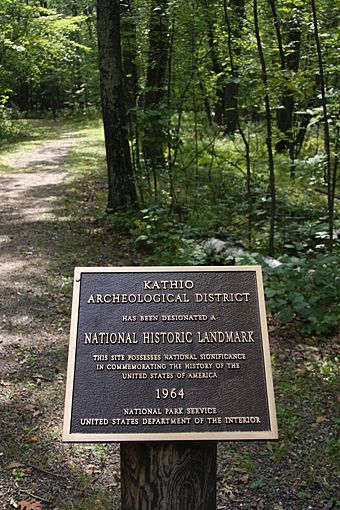Mille Lacs Kathio State Park facts for kids
|
Kathio Site
|
|

Kathio Archeological District
|
|
| Lua error in Module:Location_map at line 420: attempt to index field 'wikibase' (a nil value). | |
| Location | Mille Lacs County, Minnesota |
|---|---|
| Nearest city | Vineland, Minnesota |
| NRHP reference No. | 66000403 |
Quick facts for kids Significant dates |
|
| Added to NRHP | October 15, 1966 |
| Designated NHLD | July 19, 1964 |
Mille Lacs Kathio State Park, also known as Kathio Site, is a super interesting Minnesota state park. It's located right next to the big Mille Lacs Lake. This park is really important because it protects ancient places where people lived long ago. It also has old burial mounds. These sites tell us a lot about the Dakota Indian culture and their connections with the Ojibwe people. Some of these sites date back thousands of years!
Contents
Exploring Mille Lacs Kathio State Park
This park is like a giant outdoor history book. It has 19 different archaeological sites that have been found. This makes it one of the most important collections of ancient history in Minnesota. The oldest site here is from a time called the Archaic period. This site shows that people were making tools out of copper a very long time ago.
Who Lived Here?
The Dakota people lived in this area for a very long time. They were here until about the 1700s. Around that time, many Dakota groups started moving south. They went to live in the open prairies and along the rivers in southern Minnesota. At the same time, the Ojibwe people, also known as the Anishinaabe, started moving into this area from the east.
Ojibwe stories, written down by William Whipple Warren, tell us about a big fight. This fight, known as the Battle of Kathio, was when the Ojibwe successfully took control of the area from the Dakota.
The Logging Era
Around the 1850s, people started coming to the area to cut down trees. This was called logging. For the next 50 years, a huge number of trees were cut down. These trees were then floated down the Rum River or across Mille Lacs Lake. They were sent to sawmills to be turned into lumber.
What's in a Name?
The name "Kathio" actually comes from a mistake! The Dakota people who lived here called themselves the "Izatys." An explorer named Daniel Greysolon, Sieur du Lhut visited the area in 1679. He wrote down the name "Izatys." But his handwriting was not very clear. People later mistook the "Iz" part of the name for a "K." Then, even more mistakes happened, and the name became "Kathio."
A Special Place
Because of its rich history and many ancient sites, the Kathio Historic District was recognized as a National Historic Landmark in 1964. This means it's a very important historical place in the United States.
Images for kids






